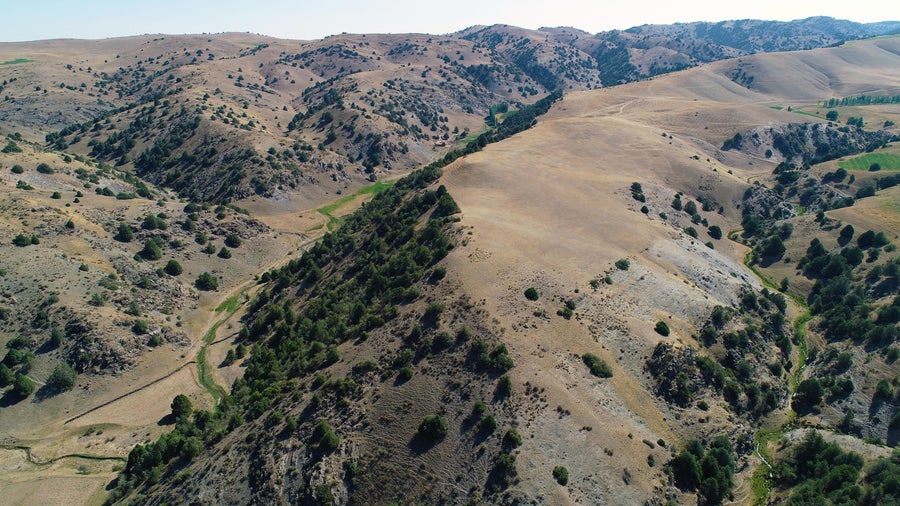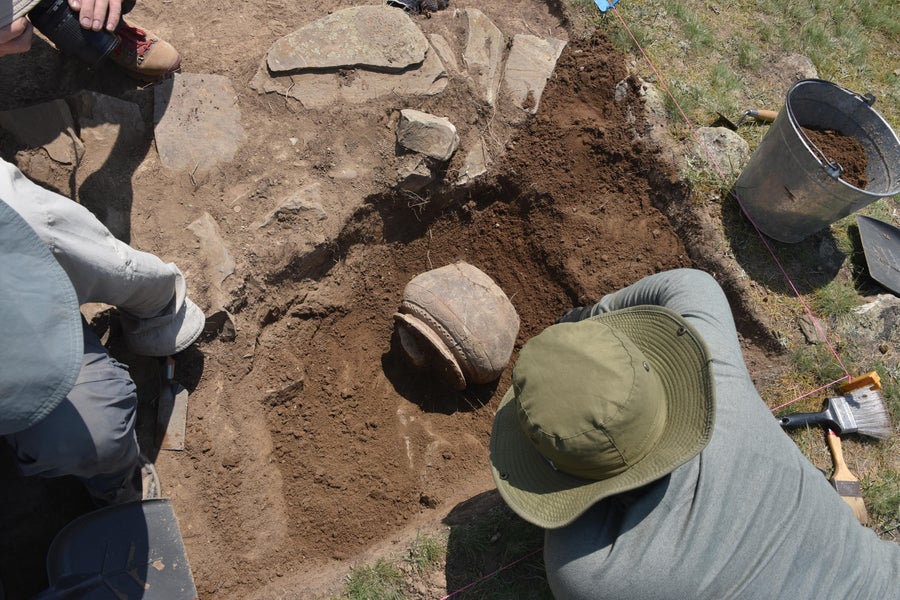Hidden within the towering mountains of Central Asia, alongside what has been known as the Silk Street, archaeologists are uncovering two medieval cities which will have bustled with inhabitants a thousand years in the past.
A staff first seen one of many misplaced cities in 2011 whereas mountain climbing the grassy mountains of japanese Uzbekistan seeking untold historical past. The archaeologists trekked alongside the riverbed and noticed burial websites alongside the way in which to the highest of one of many mountains. As soon as there, a plateau dotted with unusual mounds unfold earlier than them. To the untrained eye, these mounds would not have appeared like a lot. However “as archaeologists…, [we] acknowledge them as anthropogenic locations, as locations the place folks stay,” says Farhod Maksudov of the Nationwide Middle of Archaeology of the Uzbekistan Academy of Sciences.
The bottom, too, was plagued by hundreds of pottery shards. “We had been type of blown away,” says Michael Frachetti, an archaeologist at Washington College in St. Louis. He and Maksudov had been seeking archaeological proof of nomadic cultures that grazed their herds on the mountain pastures. The researchers by no means anticipated to discover a 30-acre medieval metropolis in a comparatively inhospitable local weather round 7,000 toes above sea degree.
On supporting science journalism
For those who’re having fun with this text, take into account supporting our award-winning journalism by subscribing. By buying a subscription you’re serving to to make sure the way forward for impactful tales in regards to the discoveries and concepts shaping our world at the moment.
However this website, known as Tashbulak, after the realm’s present-day identify, was solely the start. Whereas excavating in 2015, Frachetti met with one of many area’s solely present inhabitants—a forestry inspector who lives along with his household a number of miles from Tashbulak. “He mentioned, ‘In my yard, I’ve seen ceramics like that,’” Frachetti remembers. So the archaeologists drove to the forestry inspector’s farmstead, the place they discovered that his residence rested on a familiar-looking mound.
“Certain sufficient, he’s residing on a medieval citadel,” Frachetti says. From there, the researchers appeared out on the panorama and noticed much more mounds. “And we’re like, ‘Oh my gosh, this place is humongous,’” Frachetti provides.
This second website, named Tugunbulak, is described for the primary time in a examine printed on October 23 in Nature. The researchers used remote-sensing expertise to map what they describe as a sprawling, almost 300-acre medieval metropolis three miles from Tashbulak that was built-in into the community of commerce routes referred to as the Silk Street.
“It’s a reasonably outstanding discovery,” says Zachary Silvia, an archaeologist at Brown College, who researches this era of Central Asian historical past and tradition. (Silvia was not concerned within the new work, however he authored a commentary about it that was printed in the identical problem of Nature.) Although extra excavations are wanted to substantiate Tugunbulak’s scope and density, “even when it seems to be half the dimensions [estimated here], that’s nonetheless an enormous discovery,” he says—and one that might pressure a rethink of simply how sprawling the Silk Street networks had been.
On typical maps of the Silk Street, commerce routes spanning the Eurasian continent are inclined to keep away from the mountains of Central Asia as a lot as doable. Low-lying cities akin to Samarkand and Tashkent, which have the arable land and irrigation essential to help their bustling populations, are seen as having been the actual locations for commerce. Alternatively, the close by Pamir mountains, the place Tashbulak and Tugunbulak are situated, are rugged and largely nonarable due to their elevation. (As we speak lower than 3 % of the world’s inhabitants lives greater than 2,000 meters, or about 6,500 toes, above sea degree.)
But regardless of the restricted assets and frigid winters, folks did stay at Tashbulak and Tugunbulak from the eighth to eleventh centuries C.E., throughout the Center Ages. Finally, whether or not slowly or unexpectedly, the settlements had been deserted and left to the weather. Within the mountains, the panorama modified rapidly, and the stays of the cities had been worn down by erosion and blanketed with sediment. A thousand years later, what’s left are mounds, plateaus and ridges which might be laborious to map comprehensively with the bare eye.

A drone view of Tugunbulak.
To get an in depth lay of the land, Frachetti and Maksudov outfitted a drone with remote-sensing expertise known as lidar (gentle detection and ranging). Drones are tightly regulated in Uzbekistan, however the researchers managed to get the required permits to fly one on the website. A lidar scanner makes use of laser pulses to map the options of land under. The expertise has been more and more utilized in archaeology—up to now few years it has helped uncover a misplaced Maya metropolis sprawling beneath the rainforest cover in Guatemala.
At Tashbulak and Tugunbulak, the end result was a reduction map of the websites with inch-level element. With the assistance of laptop algorithms, handbook tracings and excavations, the researchers mapped out refined ridges that doubtless represented partitions and different buried buildings.
This technique has its limitations, Silvia says—particularly, it usually turns up false positives. It’s additionally inconceivable to substantiate which options come from which period interval with out extra excavation. Such work has been ongoing at Tashbulak however has solely simply begun at Tugunbulak. (The scans and a few excavation had been accomplished in 2022, and Frachetti’s staff returned to Tugunbulak this previous summer time to proceed excavation. The researchers have but to publish their findings.) For now, the lidar map of Tugunbulak seems to point out a large medieval advanced, full with a citadel, buildings, courtyards, plazas and pathways, bounded by fortified partitions. Together with pottery, the staff has excavated kilns, in addition to clues that staff within the metropolis smelted iron ores, Frachetti says.

Medieval pottery excavated at Tugunbulak.
Metallurgy could also be a key a part of how town might maintain itself at such a excessive altitude. The mountains are wealthy in iron ore and have dense juniper forests, which might be burned to gasoline the smelting course of. The researchers have additionally uncovered cash from throughout modern-day Uzbekistan, Maksudov says, suggesting town could have been a hub for commerce. It doesn’t seem to have been strictly a mining settlement, both—at Tashbulak, a cemetery incorporates the stays of ladies, aged folks and infants.
“We’ve realized that this was a big city heart, which was built-in into the Silk Street community and dragged the Silk Street caravans towards mountains … as a result of that they had their very own merchandise to supply,” Maksudov says.
“There’s a relationship between these cities” within the highlands and people within the lowlands, says Sanjyot Mehendale, an archaeologist and chair of the Tang Middle for Silk Street Research on the College of California, Berkeley. The buying and selling networks of the Silk Street had been “very, very fluid,” and societies as soon as thought of peripheral and distant, akin to these of Tashbulak and Tugunbulak, “had been a part of a community that stretched all throughout Eurasia,” she says. “You may not have a look at these areas and understand them as distant or much less developed.”
Mehendale turned concerned with the work at Tugunbulak after the lidar examine was accomplished, and he or she went to the positioning to excavate this previous summer time. She’s now most thinking about reconstructing what town was like throughout its life span. Who had been the inhabitants? How did the inhabitants change over seasons or centuries?
The solutions to all these questions are doubtless there, buried within the sediment. The analysis staff, Silvia says, “has obtained a lifetime of labor.”



/cdn.vox-cdn.com/uploads/chorus_asset/file/24785213/STK146_Roblox_New.jpg?w=150&resize=150,150&ssl=1)

